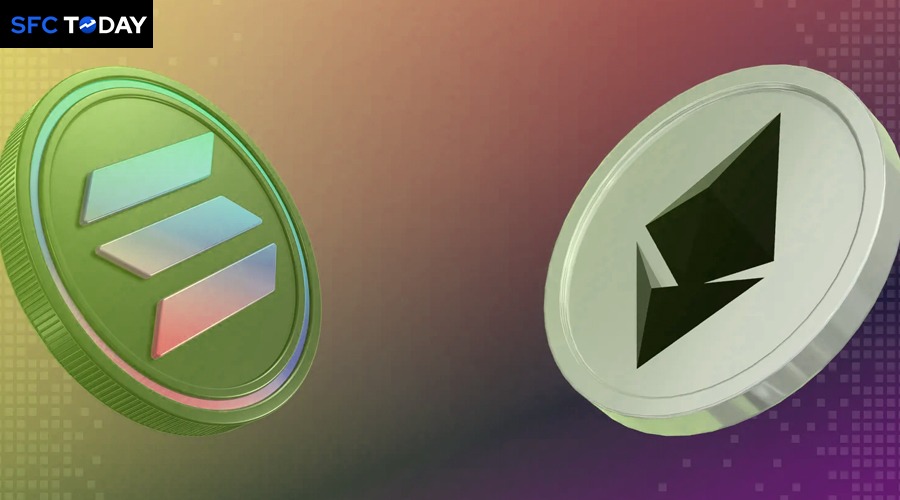Ethereum vs. Solana: Contrasting blockchain giants – differences, use cases, and industry impact
Differences Between Ethereum and Solana: Blockchain technology has reshaped industries with its promise of decentralization, security, and innovation. At the forefront of this revolution stand Ethereum and Solana, two blockchain platforms renowned for their distinct technological approaches and diverse applications.
Understanding the key differences between Ethereum and Solana is crucial for developers, businesses, and investors navigating the burgeoning blockchain landscape.
Scalability and Transaction Speed
Solana has gained prominence for its impressive scalability, processing up to 65,000 transactions per second (TPS). This capability stems from its innovative Proof of History (PoH) consensus combined with Proof of Stake (PoS).
In contrast, Ethereum currently handles around 15 TPS using Proof of Work (PoW), a figure expected to improve significantly with the transition to Ethereum 2.0’s PoS mechanism.
Solana’s high throughput and low transaction costs make it ideal for applications requiring rapid processing, such as decentralized finance (DeFi) platforms and real-time gaming interactions.
Its architecture ensures scalability without compromising efficiency, making it a preferred choice for developers aiming to scale applications quickly and cost-effectively.
Decentralization and Security
Ethereum boasts a more decentralized network with a larger number of nodes, enhancing its security by reducing vulnerabilities associated with centralization.
Ethereum’s extensive node network, established since its launch in 2015, has undergone rigorous security testing and protocol refinements over the years.
In contrast, Solana employs a delegated Proof of Stake (PoS) model, where token holders select validators. While this model introduces some centralization, Solana’s design aims to balance efficiency and security.
Being relatively newer, Solana continues to refine its security practices to strengthen its network against potential threats and attacks.
Developer Adoption and Ecosystem Growth
Ethereum pioneered blockchain-based applications with its smart contract functionality and Solidity programming language.
It boasts a robust developer community responsible for a myriad of decentralized applications (DApps) and tokens, particularly in sectors like DeFi, NFTs, and DAOs.
Ethereum’s ecosystem growth is characterized by continuous innovation and integration of new technologies to improve scalability and usability. Solana, leveraging its superior scalability and transaction speeds, has rapidly attracted developers seeking alternatives to Ethereum.
The platform’s performance advantages, combined with lower fees, have propelled its adoption across DeFi, NFTs, and gaming sectors.
Solana’s ecosystem growth is marked by the emergence of new applications and protocols leveraging its high throughput capabilities, demonstrating its potential for scalable blockchain solutions.
Smart Contract Capabilities and Compatibility
Ethereum revolutionized smart contracts with its Solidity programming language, which, while powerful, presents a learning curve for developers.
Nonetheless, Solidity’s extensive developer community has fostered a diverse ecosystem of smart contracts powering various decentralized applications on Ethereum’s network.
Solana differentiates itself by supporting multiple programming languages for smart contracts, offering developers greater flexibility and ease of integration. Its compatibility initiatives, such as striving for Ethereum Virtual Machine (EVM) compatibility, aim to facilitate seamless migration of Ethereum-based projects to Solana.
This interoperability strategy not only expands Solana’s developer base but also enhances its utility as a scalable blockchain platform for existing Ethereum users seeking performance improvements.
Conclusion
In conclusion, differences between Ethereum and Solana represent distinct approaches within the blockchain landscape, each catering to different needs and applications.
Solana excels in scalability and transaction speed, making it ideal for applications requiring high throughput and low latency, such as gaming and micro-transactions. Ethereum, with its robust decentralization, security, and established ecosystem, remains the platform of choice for complex decentralized applications in sectors like DeFi and NFTs.
As both platforms continue to evolve and innovate, their respective strengths and target markets will likely shape the future of blockchain technology.
Developers and businesses exploring blockchain solutions must consider these key differences and use cases to determine the most suitable platform for their specific requirements and growth strategies.
In summary, while Solana offers superior scalability and transaction speed, Ethereum provides a more decentralized and secure environment with a well-established ecosystem.
Both platforms contribute significantly to the blockchain revolution, offering diverse solutions that drive innovation across various industries.


